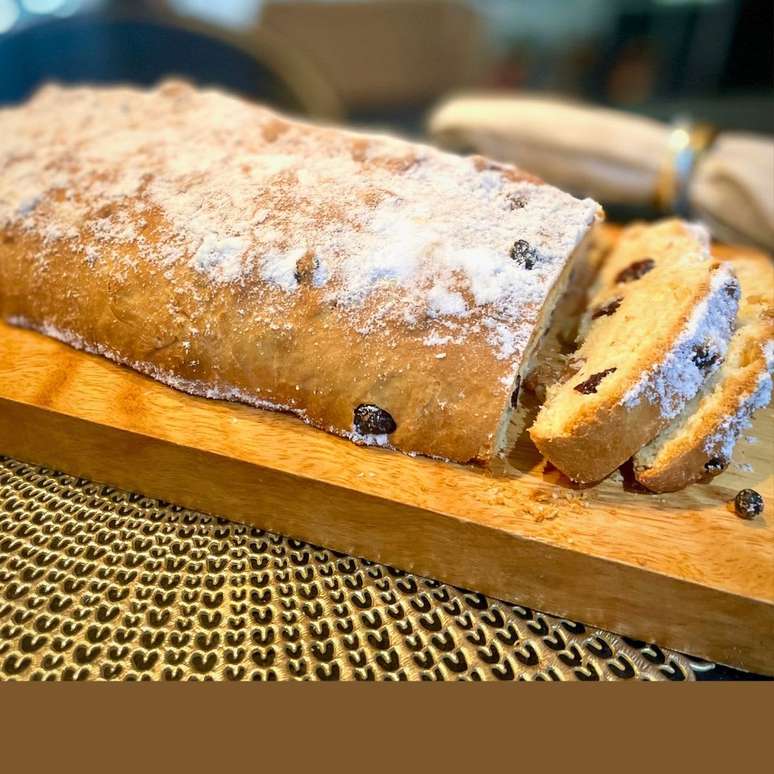A German Christmas sweet bread, with dried fruit, citrus zest and spices. A delicious tradition to enrich Christmas
A German Christmas sweet bread, with dried fruit, citrus zest and spices. A delicious tradition to enrich Christmas
Recipe for 2 people.
Classic (no restrictions), Vegetarian
Preparation: 03:30 + cooling time
Interval: 3:00
TOOLS
2 bowls, 1 pan(s), 1 baking dish or baking dish, 1 rolling pin (optional), 1 brush(es), 1 spatula(s), 1 pan(s) (optional), 1 cutting board(s), 1 rack , 1 strainer(s) (for dusting), 1 grater
EQUIPMENT
conventional + mixer with hook whisk (optional)
METERS
cup = 240 ml, spoon = 15 ml, teaspoon = 10 ml, teaspoon = 5 ml
Ingredients for the sponge:
– 60 ml of hot milk
– 10 g of sugar
– 60 g of special wheat flour for bread
– 5 g of dry organic yeast
TRADITIONAL STOLLE Ingredients: PASTA
– 150 g of special wheat flour for bread
– 30 g of sugar
– 1 small beaten egg(s)
– 100 g of softened unsalted butter
– 1/4 teaspoon of vanilla essence
– 2 tablespoons of milk to highlight (optional)
– ground cinnamon to taste
– powdered cloves to taste
– nutmeg to taste, grated
– cardamom powder to taste
– 1/2 teaspoon(s) of salt
STUFFING Ingredients:
– 30 g dried cranberries (or raisins)
– 30 g of black and white raisins, mixed
– 30 g of mixed candied fruit (or raisins)
– 1/2 unit of orange peel (avoid the white part)
– 20 g of raw almonds (or walnuts), without peel, coarsely chopped
– 50 ml of rum (to hydrate the dried fruit) (or orange juice)
Ingredients TO COMPLETE:
– 10 g unsalted melted butter (or as needed)
– icing sugar to taste for dusting
PREPARATION:
- Separate the recipe ingredients and utensils. The yield is one 400g sweet bread for every 2 portions.
- Hydrated dried fruit:
- Mix dried fruit with rum or orange juice.
- Let sit in a covered container at room temperature for at least 2 hours or overnight.
- Chop the walnuts or almonds into smaller pieces. If necessary, toast lightly over low heat in a pan to enhance the flavor and crunchiness.
- Prepare the sponge cake – see preparation.
- Remove the butter from the refrigerator and use it as an ointment. Beat the egg(s) and set aside.
PREPARATION:
Sponge (do this step during pre-preparation):
- Heat the milk until lukewarm, being careful not to heat it too much as this will kill the yeast.
- In a bowl, mix the warm milk, yeast, sugar and flour for the sponge cake.
- Cover and let sit for 30 minutes until frothy.
- Note: If the sponge does not foam within 30 minutes, the yeast may be inactive. In this case, restart the sponge cake with new yeast.
- Return to pre-preparation (step 5).
Stollen – Preparation of the dough:
- Mix the remaining bread flour, sugar and spices.
- Add the fermented sponge cake, beaten egg(s) and vanilla essence.
- Mix until a homogeneous mixture is formed.
- Note: If the dough seems dry, slowly add a small amount of milk (see amount in dough ingredients).
- Knead for a few minutes to incorporate the ingredients.
- Then add the butter until creamy, mix to homogenize.
- Add the salt, and knead for 10-12 minutes by hand or 6-7 minutes with the mixer until you obtain a smooth (elastic) tip and a smooth, but still a little sticky dough.
Incorporate the filling into the prepared dough:
- Drain the hydrated fruit and mix it with the grated lemon and grated orange zest.
- Roll out the dough into a rectangle, distribute the filling and fold it over the fruit.
- Knead gently to incorporate and form a ball.
First Fermentation:
- Place the dough in a greased bowl, cover, flour the surface and let it rest at room temperature for 1h30 or until it doubles in volume.
- To find the sweet spot: lightly touch the dough with your finger. If the imprint slowly returns, the fermentation is finished.
Modeling and second fermentation:
- Roll out the dough into a rectangle of approximately 20 x 15 cm (2 portions) and 40 x 30 cm (4 portions). For larger quantities, divide the dough into smaller loaves.
- Fold one of the longer sides of the rectangle(s) to the center, covering two-thirds of the width.
- Fold the other longer side, aligning it with the bottom edge, forming an overlap.
- Press gently to seal the folds and create the classic Stollen shape, slightly elongated and domed.
- Place the Stollen on the baking tray seam side down. For a more rustic effect you can cook it with the seam facing upwards, as long as it is well sealed to prevent it from opening in the oven.
- Cover with cling film and leave to rise for another hour or until the ideal growth point is reached.
- How to know if the dough is at the ideal growing point.
- The dough should rise visibly and feel light to the touch.
- When you lightly press the dough, it should spring back slowly without collapsing.
- If the dough does not rise visibly within 1 hour, it may take longer, especially if the room is cold.
Cook and finish:
- Preheat the oven to 180°C.
- Bake for 30 minutes or until golden brown. If the Stollen darkens quickly, cover it with aluminum foil.
- Melt the butter a little before removing the bread from the oven.
- Remove from the oven and brush with melted butter while still hot.
- Sprinkle the still warm bread generously with icing sugar.
FINALIZATION AND ASSEMBLY:
- Leave the Stollen cool completely before cutting. Stollen gets even better after 1 or 2 days as the fruit and spice flavors intensify.
- If necessary, dust the surface again with icing sugar.
- Serve in thin slices, accompanied by coffee or tea.
- Storage: wrap well in cling film and aluminum foil. Can be frozen for up to 3 months.
Source: Food Challenges – Bia Freitag – Tested by Bake and Cake Gourmet
Do you want to make this recipe? Access the shopping list, HERE.
To see this recipe for 2, 6, 8 people, Click here.
Create your personalized menu for free on Bake and gourmet cakes.

Source: Terra
Ben Stock is a lifestyle journalist and author at Gossipify. He writes about topics such as health, wellness, travel, food and home decor. He provides practical advice and inspiration to improve well-being, keeps readers up to date with latest lifestyle news and trends, known for his engaging writing style, in-depth analysis and unique perspectives.








